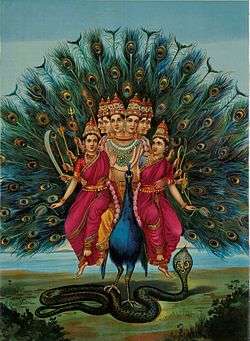Kaumaram
Kaumaram is a denomination which focuses on the deity Kumara, also known as Murugan, Kandan or Kadamban Kartikeya. Most devotees of Kumara also revere members of his family: Parvati, Shiva and Ganesha. The important theological texts relating to Kumara are a part of the Shaiva agama canon. This sub-tradition is found in South India, Sri Lanka, Malaysia and among the Tamil diaspora worldwide.[1]
| Part of the series on |
| Kaumaram |
|---|
 |
|
Six sacred abodes
|
|
The term Kaumaram also means "childhood, youth" in Hindu texts, as in verse 2.13 of the Bhagavad Gita.[2] It is sometimes a substitute for Brahmacharya stage of life.[3]
References
- Roshen Dalal (2010). Hinduism: An Alphabetical Guide. Penguin Books. pp. 417–418, 137, 198–199, 241, 425. ISBN 978-0-14-341421-6.
- Winthrop Sargeant; Christopher Key Chapple (1984). The Bhagavad Gita: Revised Edition. State University of New York Press. p. 98. ISBN 978-0-87395-831-8.
- Suresh Chandra (1998). Encyclopaedia of Hindu Gods and Goddesses. Sarup & Sons. p. 63. ISBN 978-81-7625-039-9.
External links

- Murugan devotion, Temples, Songs, Festivals
- ST Temple, Dedicated to Murugan, Singapore
This article is issued from Wikipedia. The text is licensed under Creative Commons - Attribution - Sharealike. Additional terms may apply for the media files.
